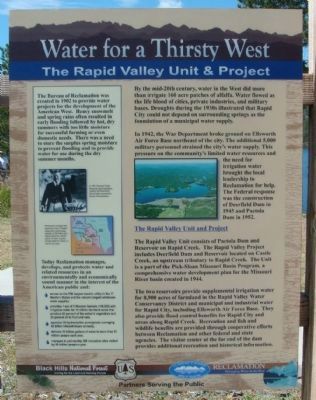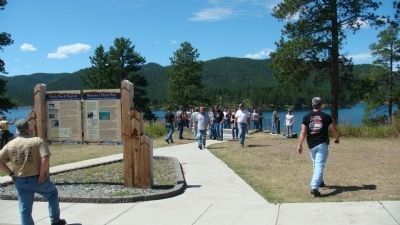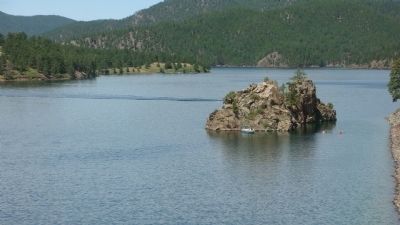Near Johnson Siding in Pennington County, South Dakota — The American Midwest (Upper Plains)
Water for a Thirsty West
The Rapid Valley Unit & Project
In 1942, the War Department broke ground on Ellsworth Air Force Base northeast of the city. The additional 5,000 military personnel strained the city's water supply. This pressure on the community's limited water resources and the need for irrigation water brought the local leadership to Reclamation for help. The Federal response was the construction of Deerfield Dam in 1945 and Pactola Dam in 1952.
The Rapid Valley Unit and Project
The Rapid Valley Unit consists of Pactola Dam and Reservoir on Rapid Creek. The Rapid Valley Project includes Deerfield Dam and Reservoir located on Castle Creek, an upstream tributary to Rapid Creek. The Unit is a part of the Pick-Sloan Missouri Basin Program, a comprehensive water development plan for the Missouri River basin created in 1944.
The two reservoirs provide supplemental irrigation water for 8,900 acres of farmland in the Rapid Valley Water Conservancy District and municipal and industrial water for Rapid City, including Ellsworth Air Force Base. They also provide flood control benefits for Rapid City and areas along Rapid Creek. Recreation and fish and wildlife benefits are provided through cooperative efforts between Reclamation and other federal and state agencies. The visitor center at the far end of the dam provides additional recreation and historical information.
Caption for photo: Pactola Dam
Sidebar:
The Bureau of Reclamation was created in 1902 to provide water projects for the development of the American West. Heavy snowmelt and spring rains often resulted in early flooding followed by hot, dry summers with too little moisture for successful farming or even domestic needs. There was a need to store the surplus spring moisture to prevent flooding and to provide water for use during the dry summer months.
Caption for photo: In 1902, President Teddy Roosevelt signed legislation creating the Reclamation Service (later named the Bureau of Reclamation).
Caption for map: Reclamation manages 348 reservoirs in the 17 western states with a total storage capacity of 245 million acre-feet (an acre-foot, 325,551 gallons of water, supplies enough water for a family of four for one year).
Today Reclamation manages, develops, and protects water and related resources in an environmentally and economically sound manner in the interest of the American public and:
• serves as the fifth largest electric utility in the 17 Western States and the nation's largest wholesale water supplier,
• provides 1 out of 5 Western farmers (140,000) with irrigation water for 10 million farmland acres that produce 60 percent of the nation's vegetables and 25 percent of its fruit and nuts,
• operates 58 hydroelectric powerplants averaging 42 billion kilowatt-hours annually,
• delivers 10 trillion gallons of water to more than 31 million people each year,
• manages in partnership 308 recreation sites visited by 90 million people a year.
Erected by the U.S. Forest Service and the Bureau of Reclamation of the U.S. Department of the Interior.
Topics and series. This historical marker is listed in these topic lists: Man-Made Features • Waterways & Vessels. In addition, it is included in the Former U.S. Presidents: #26 Theodore Roosevelt series list. A significant historical year for this entry is 1942.
Location. 44° 4.539′ N, 103° 29.385′ W. Marker is near Johnson Siding, South Dakota, in Pennington County. Marker is on U.S. 385, 0.1 miles Pactola Basin Road, on the right when traveling south. Touch for map. Marker is in this post office area: Rapid City SD 57702, United States of America. Touch for directions.
Other nearby markers. At least 8 other markers are within 10 miles of this marker, measured as the crow flies. Pactola Dam & Reservoir (here, next to this marker); Civilian Conservation Corps Camp (approx. half a mile away); a different marker also named Civilian Conservation Corps Camp (approx. 5.1 miles away); a different marker also named Civilian Conservation Corps Camp (approx. 6.8 miles away); Historic Madison Ranch (approx. 6.9 miles away); Sheridan (approx. 7˝ miles away); Castleton (approx. 8.3 miles away); a different marker also named Civilian Conservation Corps Camp (approx. 9.2 miles away). Touch for a list and map of all markers in Johnson Siding.
Credits. This page was last revised on June 16, 2016. It was originally submitted on October 19, 2010, by William J. Toman of Green Lake, Wisconsin. This page has been viewed 998 times since then and 55 times this year. Photos: 1, 2, 3. submitted on October 19, 2010, by William J. Toman of Green Lake, Wisconsin. • Syd Whittle was the editor who published this page.


